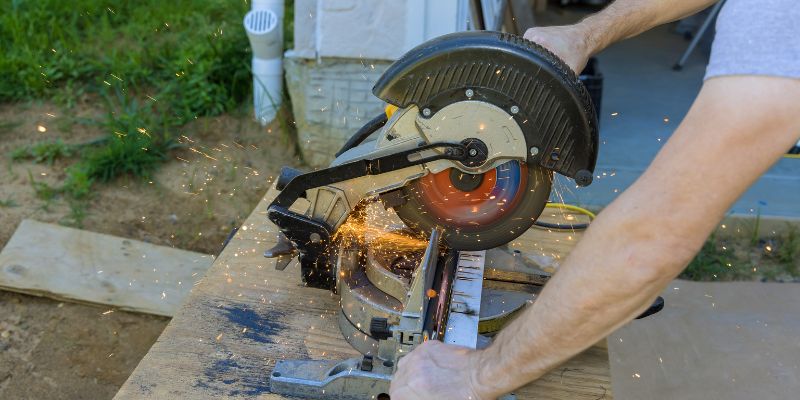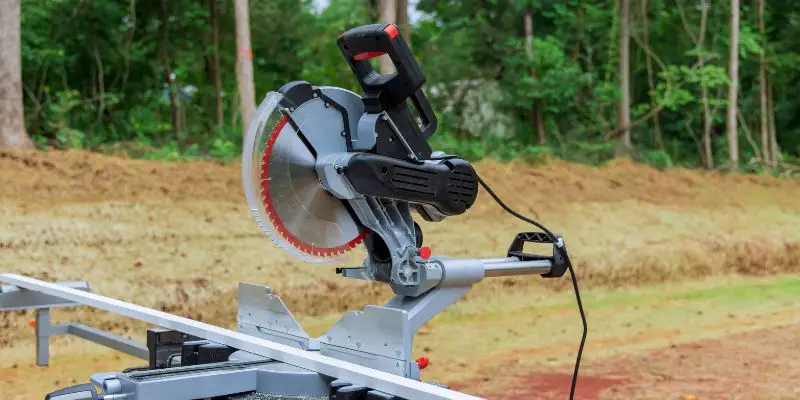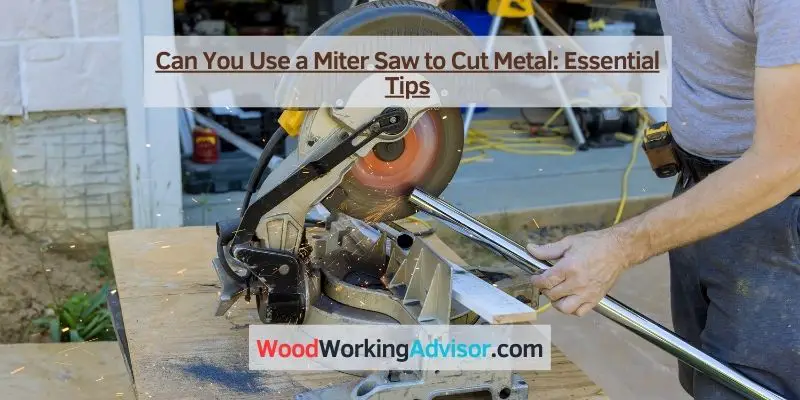Yes, a miter saw can be used to cut metal with the appropriate blade. Metal-cutting blades are available for miter saws, allowing for precise and efficient cutting of various metals.
When equipped with the correct blade and safety measures in place, a miter saw can effectively cut metal, making it a versatile tool for both woodworking and metalworking projects. A miter saw is a powerful and versatile tool that is commonly used for making precise angled cuts in wood.
However, with the right blade, it can also be utilized to cut various types of metals, including aluminum, steel, and other non-ferrous metals. This extends the functionality of the miter saw, making it a valuable addition to a workshop for those who work with both wood and metal. Understanding the proper blade and safety precautions for cutting metal with a miter saw is essential for achieving accurate and clean results while ensuring a secure working environment.
Understanding Your Miter Saw
Miter saws are versatile power tools that are primarily used for making accurate crosscuts and angled cuts. One common question that often arises among DIY enthusiasts and professionals alike is whether a miter saw can be used to cut metal. Understanding your miter saw and its capabilities is crucial to safely and effectively using it for various materials.

Review Different Types Of Miter Saws
When considering whether you can use a miter saw to cut metal, it’s important to review the different types of miter saws available. The common types include the basic miter saw, compound miter saw, sliding compound miter saw, and dual compound miter saw. Each type has its own unique features and specifications, which can impact its ability to cut metal effectively.
Discuss Saw Components Relevant To Cutting Different Materials
The components of a miter saw that are relevant to cutting different materials include the blade, motor power, and blade speed. Understanding how these components interact with the material being cut is essential. Selecting the appropriate saw blade designed for cutting metal, along with a powerful motor and suitable blade speed, is crucial in achieving clean and accurate metal cuts.
Importance Of Knowing Your Tool’s Capabilities And Limitations
Knowing your miter saw’s capabilities and limitations is essential for safe operation and achieving the desired results. Understanding the material compatibility, maximum cutting capacity, and safety precautions for metal cutting are crucial factors to consider. By being aware of these aspects, you can optimize the performance of your miter saw while ensuring safety and precision.
Choosing The Right Blade For Metal
When it comes to cutting metal using a miter saw, choosing the right blade is crucial for achieving precise and clean cuts. Understanding the role of blade material, tooth count, and proper installation and maintenance can significantly impact the performance and longevity of your saw when cutting metal. Let’s delve into the factors to consider when selecting the appropriate blade for cutting metal with a miter saw.
The Role Of Blade Material In Cutting Performance
The blade material plays a vital role in determining the cutting performance when working with metal. Steel, aluminum, and other ferrous metals require specialized blades that are constructed from high-speed steel (HSS) or carbide-tipped materials. These materials provide the necessary hardness and durability to withstand the rigors of metal cutting, ensuring clean and precise cuts without premature wear or damage to the blade.
Blade Tooth Count And Its Impact On Metal Cuts
The tooth count of the blade is another critical consideration for cutting metal with a miter saw. For efficient metal cutting, opt for a blade with a higher tooth count, ideally ranging from 14 to 18 teeth per inch (TPI). A higher tooth count enables smoother cuts and reduces the risk of chipping or burring, resulting in cleaner and more accurate metal cuts.
Tips For Proper Blade Installation And Maintenance
Proper installation and maintenance of the blade are essential to maximize its cutting performance and longevity. When installing the metal-cutting blade, ensure that it is securely fastened and aligned with the miter saw’s arbor to prevent vibrations and potential blade slippage during operation.
- Regularly inspect the blade for any signs of dullness, wear, or damage, and promptly replace it when necessary to maintain optimal cutting performance.
- Keep the blade and the cutting area clean and free from metal shavings and debris to prevent overheating and potential blade binding during operation.
- Applying a few drops of lubricating oil to the blade before each use can help reduce friction and heat buildup, prolonging the blade’s lifespan and maintaining its cutting efficiency.
Preparing To Cut Metal With A Miter Saw
When using a miter saw to cut metal, proper preparation is vital to ensure safe and efficient operation. Before diving into the metal cutting process, it’s essential to take necessary precautions and make necessary adjustments to the equipment. In this section, we’ll discuss the crucial aspects of preparing to cut metal with a miter saw, including the importance of safety gear, securing the metal material, and adjusting the saw settings for metal work.
Importance Of Safety Gear For Metal Cutting
Cutting metal with a miter saw poses potential safety hazards, making the use of appropriate safety gear imperative. Wearing personal protective equipment (PPE) such as safety goggles, gloves, and ear protection can prevent injuries and shield you from metal chips and debris. Additionally, a dust mask is essential to protect your respiratory system from metal dust and particles generated during the cutting process.
Steps To Secure Metal Material Before Cutting
Prior to cutting metal with a miter saw, it’s crucial to securely fasten the material to prevent slippage or movement during the cutting operation. Using clamps or vises to secure the metal firmly in place on the miter saw’s work surface will ensure stability and accuracy during the cutting process. Double-checking the stability of the metal before initiating the cut is essential to avoid potential mishaps and ensure precise cuts.
Adjusting Miter Saw Settings For Metal Work
When working with metal, adjusting the miter saw settings is essential to achieve optimal cutting results. Begin by selecting the appropriate blade designed specifically for cutting metal, ensuring that it’s securely mounted and in good condition. Adjust the saw’s blade speed to match the type and thickness of the metal, as higher blade speeds are generally preferred for cutting through metal. Additionally, setting the saw’s angle and bevel to match the desired cutting angles is crucial for precise and accurate cuts.
Execution: Safely Cutting Metal
Cutting metal with a miter saw can be a versatile and efficient process when executed safely and with the correct techniques. By following a step-by-step guide and implementing the right tips and techniques, you can achieve clean and precise cuts on various metals. In this section, we will discuss the step-by-step guide to using a miter saw on metal, techniques to avoid common mistakes and accidents, and tips for achieving clean and precise cuts on different metals.
Step-by-step Guide To Using A Miter Saw On Metal
When using a miter saw to cut metal, it is important to follow a systematic approach to ensure safety and precision. Here’s a step-by-step guide to using a miter saw on metal:
- Secure the metal workpiece in place using clamps or a vise to prevent any movement during the cutting process.
- Select the appropriate blade for cutting metal, ensuring it is sharp and suitable for the type of metal being cut.
- Adjust the miter saw’s speed and ensure it is set to the appropriate RPM for cutting metal.
- Wear safety gear such as gloves, goggles, and ear protection to safeguard against metal shards and noise.
- Position the metal workpiece securely against the miter saw fence and ensure it is clamped tightly to prevent any potential kickback.
- Activate the miter saw and carefully guide the blade through the metal workpiece, maintaining a steady and controlled motion.
- Allow the miter saw blade to come to a complete stop before removing the cut metal piece.
Techniques To Avoid Common Mistakes And Accidents
When cutting metal with a miter saw, it’s crucial to implement proper techniques to avoid potential mistakes and accidents. Here are some techniques to keep in mind:
- Always use clamps or a vise to secure the metal workpiece firmly in place.
- Avoid forcing the blade through the metal, as this can lead to blade binding and kickback.
- Ensure the miter saw’s blade guard is functioning properly and in place to protect against any contact with the blade.
- Regularly inspect the blade for any signs of wear or damage, and replace it as needed to maintain cutting precision and safety.
Tips For Achieving Clean, Precise Cuts On Various Metals
When aiming for clean and precise cuts on different types of metals, certain tips can enhance the cutting process. Consider the following tips:
- Use a specialized carbide-tipped blade for cutting harder metals such as steel, and a high-speed steel blade for softer metals like aluminum.
- Apply a lubricant or cutting fluid to the metal workpiece to reduce friction and heat buildup during the cutting process, enhancing blade longevity and cutting quality.
- Support the metal workpiece with a sacrificial backing to prevent burrs and deformation on the underside of the cut.
- Regularly clean the miter saw’s cutting area and inspect for metal debris buildup to maintain cutting performance and safety.
Ensuring Longevity Of Your Miter Saw
As a proud owner of a miter saw, you understand the importance of maintaining and taking care of your tools. When it comes to cutting metal, your miter saw can be a versatile and powerful tool if properly cared for. Ensuring the longevity of your miter saw involves regular cleaning and maintenance, replacing blades and servicing the saw at the right time, and safely storing it when not in use. Let’s dive into the best practices to uphold the functionality and durability of your miter saw.

Cleaning And Maintaining Your Miter Saw After Use
After using your miter saw to cut metal, it’s essential to clean it to prevent the buildup of metal shavings and debris, which can affect the saw’s precision and performance. Here are some basic cleaning and maintenance tips to remember:
- Always unplug the saw before cleaning.
- Remove any metal chips and dust from the blade guard, base, and other parts using a brush and a vacuum.
- Wipe down the surfaces with a dry cloth to remove any remaining debris.
- Apply a light coat of lubricant to the moving parts to prevent rust and ensure smooth operation.
When To Replace Blades And Service Your Saw
Replacing blades and servicing your miter saw at regular intervals are essential for maintaining its cutting efficiency and precision. Keep an eye out for the following signs that indicate it’s time to replace the blade:
- Decreased cutting performance or rough edges on metal materials.
- Visible tooth damage or dullness on the blade.
- Unusual vibrations or noises during operation.
Servicing your miter saw at recommended intervals, typically outlined in the user manual, can help identify and address any underlying issues before they escalate and affect the saw’s performance.
Best Practices For Storing Your Miter Saw Safely
Proper storage is crucial for protecting your miter saw from damage and maintaining its longevity. Consider the following best practices for safely storing your miter saw:
- Store the saw in a dry and well-ventilated area to prevent rust and corrosion.
- Keep the blade guard in place when the saw is not in use to prevent accidental contact with the blade.
- Use a cover or case to shield the saw from dust, moisture, and other environmental factors.
- Secure the saw to prevent it from tipping over or falling during storage.
Frequently Asked Questions Of Can You Use A Miter Saw To Cut Metal
Can A Miter Saw Be Used To Cut Metal?
Yes, a miter saw can be used to cut metal, but it requires a specific blade designed for metal cutting. It’s important to ensure that the saw has the appropriate power and speed settings for cutting metal.
What Type Of Blade Is Used For Cutting Metal With A Miter Saw?
A carbide-tipped blade specifically designed for cutting metal should be used with a miter saw. These blades are constructed to withstand the hardness and abrasiveness of metal while providing accurate and clean cuts.
Are There Any Safety Precautions When Cutting Metal With A Miter Saw?
When cutting metal with a miter saw, it’s crucial to wear proper safety gear, including eye protection and gloves. Additionally, securing the metal firmly in place and using the correct blade is essential to ensure safety during the cutting process.
Can A Miter Saw Be Used For Both Wood And Metal Cutting?
Yes, a miter saw can be versatile and used for cutting both wood and metal. When equipped with the appropriate blade, it can efficiently handle various materials, making it a versatile tool for different types of projects.
Conclusion
A miter saw can be used to cut metal with the appropriate blade. Understanding the right blade, safety precautions, and techniques is essential for successful metal cutting. Always prioritize safety and use the proper safety gear when working with a miter saw.
With the correct approach, a miter saw can be a versatile tool for metal cutting projects.


